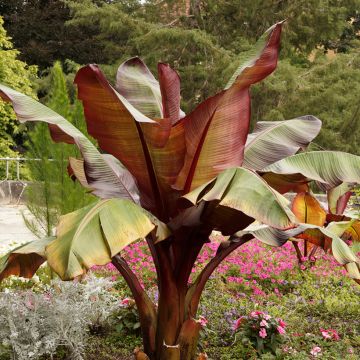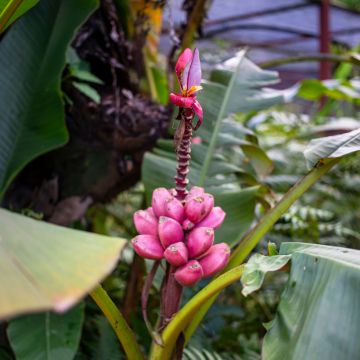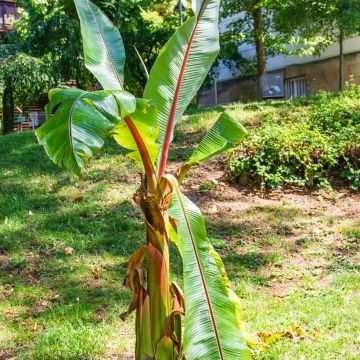

Musella lasiocarpa - Golden Lotus Banana


Musella lasiocarpa - Golden Lotus Banana
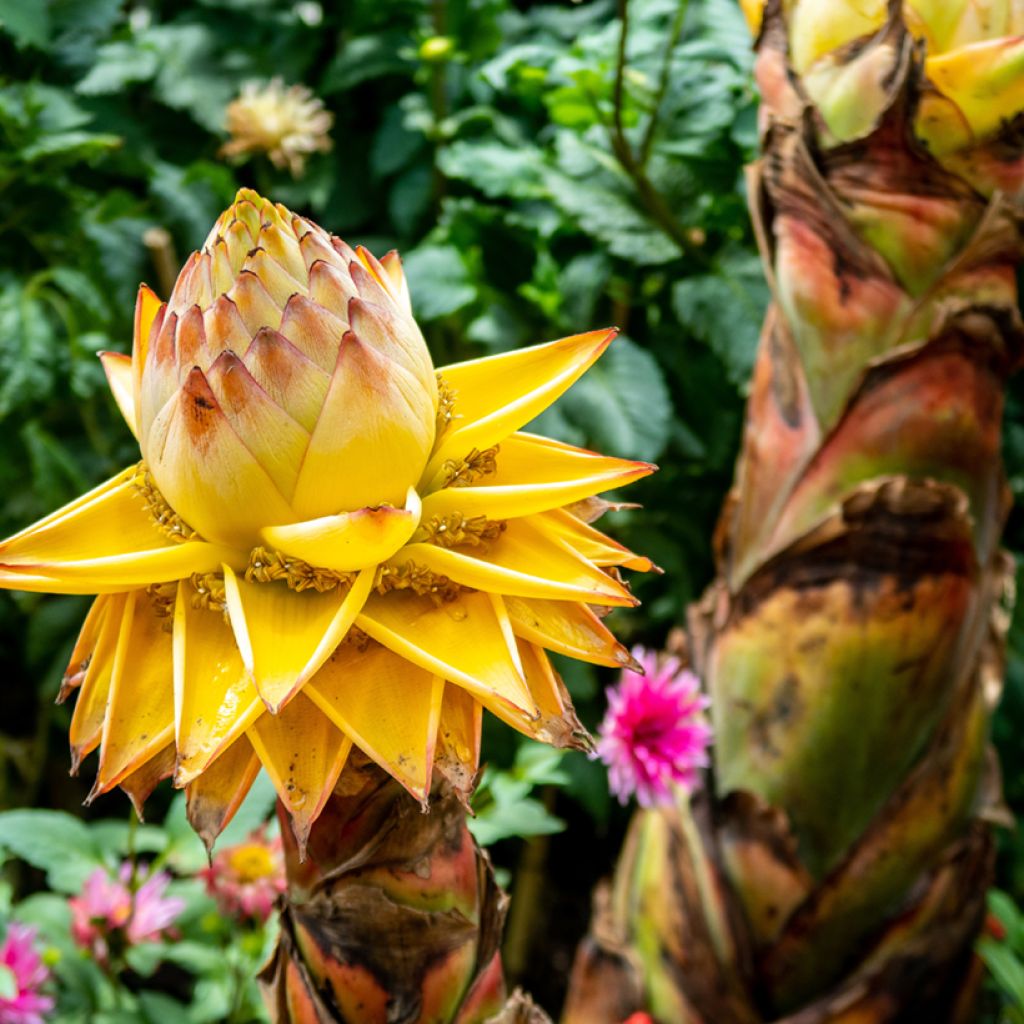

Musella lasiocarpa - Golden Lotus Banana


Musella lasiocarpa - Golden Lotus Banana


Musella lasiocarpa - Golden Lotus Banana
View more pictures
Hide images

Christophe N.

Nain Banana Tree
Christophe N.

Alina M.

This is a plant that I absolutely adore! The Musella lasiocarpa - Dwarf Banana Tree is a real gem in my garden. It's so exotic and unique, and the yellow flowers are simply stunning. I highly recommend it to anyone looking to add a touch of tropical paradi
Alina M. • 01 FR
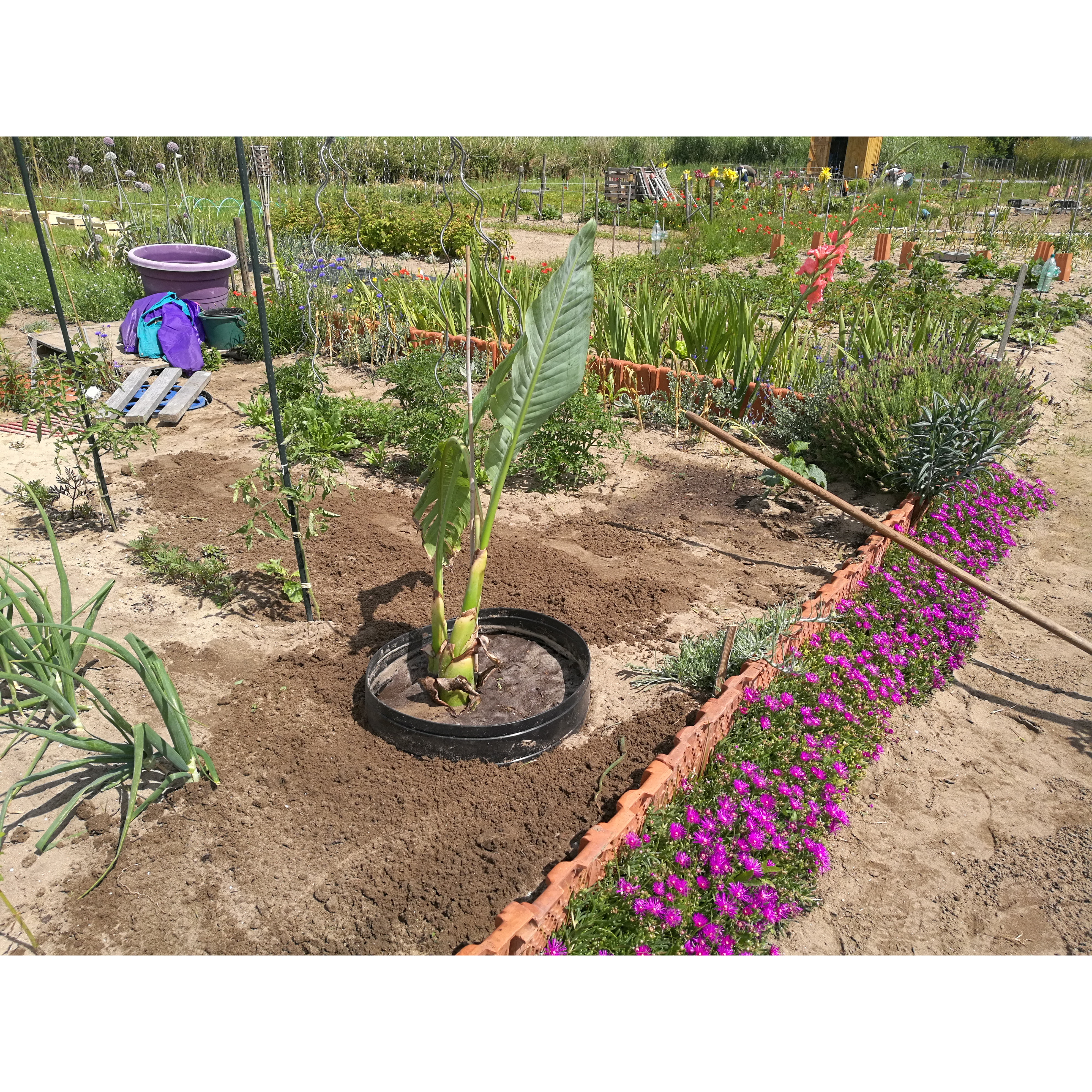
Isabelle A.

Wonderful.
Isabelle A. • 85 FR
Musella lasiocarpa - Golden Lotus Banana
Musella lasiocarpa
Golden Lotus Banana, Chinese Dwarf Banana, Yellow Banana
Mine is starting to flower! Have another ‘baby’ growing - great plant.
botanicalannie, 30/05/2025
Special offer!
Receive a €20 voucher for any order over €90 (excluding delivery costs, credit notes, and plastic-free options)!
1- Add your favorite plants to your cart.
2- Once you have reached €90, confirm your order (you can even choose the delivery date!).
3- As soon as your order is shipped, you will receive an email containing your voucher code, valid for 3 months (90 days).
Your voucher is unique and can only be used once, for any order with a minimum value of €20, excluding delivery costs.
Can be combined with other current offers, non-divisible and non-refundable.
Home or relay delivery (depending on size and destination)
Schedule delivery date,
and select date in basket
This plant carries a 24 months recovery warranty
More information
We guarantee the quality of our plants for a full growing cycle, and will replace at our expense any plant that fails to recover under normal climatic and planting conditions.
Would this plant suit my garden?
Set up your Plantfit profile →
Description
Musella lasiocarpa is also called Chinese dwarf banana or golden lotus, referring to its habit and its magnificent golden-yellow inflorescence. This beautiful perennial shrub resembles a banana tree, its close relative. It is distinguished by its dwarf habit and its unique flowering, which can last several months. This relatively hardy plant produces numerous shoots, forming beautiful groups over time with lush foliage. It is resistant to wind, cold, and occasionally dry soils. It is easy to grow in large containers, indoors or outdoors. It appreciates fertile, moist, but well-drained soils and thrives in full sun or partial shade.
Musella lasiocarpa belongs to the Musaceae family, native to China (Yunnan province) and Vietnam, at altitudes up to 2,500 m (1640.4 ft). It is therefore quite hardy but not yet widely cultivated enough to determine its exact resistance capabilities. This species, which has become very rare in the wild, owes its survival only to cultivation. It is a monocarpic perennial plant (dies after fruiting) with tuberous rhizomes. It is a small banana tree, forming numerous shoots at the base, capable of reaching 1.5 m to 1.8 m (4.9 ft to 5.9 ft) in height in our climates. It is remarkable for its ornamental qualities, hardiness, and fast growth. A seed germinated in spring can form a plant of 1.5 m (4.9 ft) in the space of one summer. The leaves are quite large, more fibrous and sturdy than those of banana trees, with a bluish-green colour. The flowering can last from 6 months to a year. The apical bud then produces a dense spike of thick yellow bracts, resembling a lotus flower, carried by a thick stem. The small flowers develop at the base of the bracts. The fertilised flowers give way to small fruits containing seeds that easily germinate when fresh. It is a hardy, evergreen plant in mild climates.
Musella lasiocarpa is used in mass plantings or as a solitary specimen, in containers or in the ground, in any region. It is hardy enough to grow in the ground, with or without protection depending on the climate. It pairs well, for example, with orange cannas or variegated foliage plants. Plant it in a large container as a standalone specimen for a terrace. It can be stored in a cold greenhouse during winter, in a very bright location. In a conservatory setting, it goes well with other orangery plants such as oleanders, citrus trees, Chilean myrtle, mimosas, or Strelitzia reginae.
Just like perennial plants, banana trees are dormant during winter: their above-ground parts dry up and die. Plants shipped in winter are therefore pruned to the ground (leaves and stems) by our teams to allow for a better start in spring.
Report an error about the product description
Musella lasiocarpa - Golden Lotus Banana in pictures




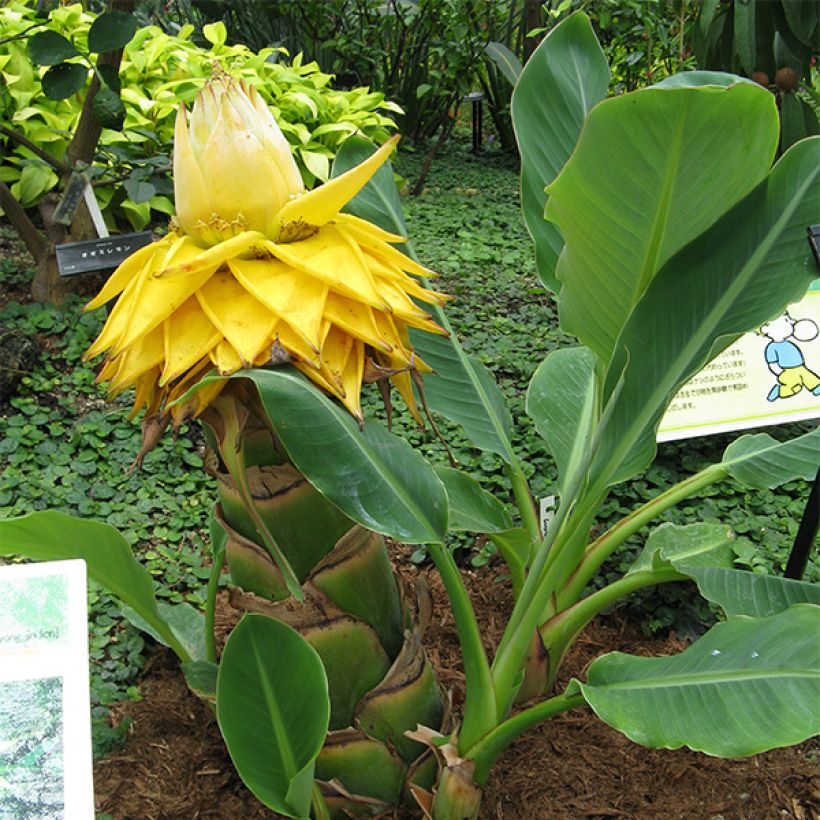

Plant habit
Flowering
Foliage
Botanical data
Musella
lasiocarpa
Musaceae
Golden Lotus Banana, Chinese Dwarf Banana, Yellow Banana
China
Other Musa - Banana tree
View all →Planting and care
Musella lasiocarpa should be grown in full sun or partial shade, in a rich, rather moist, but well-drained soil, either in the ground or in a large container. It tolerates short periods of drought and fairly cold or snowy winters quite well. The Chinese dwarf banana tree dislikes waterlogged soils in winter. In very cold or very wet regions in winter, it is useful to protect it with a thick and loose layer of straw, covered with a transparent tarpaulin or sheet to isolate the stump and young shoots from moisture. These protections should be removed once the frosts have passed. The exposure should be sunny. The aerial parts are destroyed by frost from -2° C (28.4° F). They then fall onto the stump, protecting the underground buds. New shoots emerge vigorously and rapidly in spring. The plant can withstand temperatures down to -12° C (10.4° F), and possibly even lower.
Cultivation in pots:
If growing in pots, use a good substrate. The following mixture works well: ¼ garden soil, ¼ potting soil, ¼ coarse horticultural sand or pumice, and ¼ well-decomposed manure, as it is a nutrient-hungry plant. A layer of clay balls at the bottom of the mix improves drainage. This plant, when grown in a pot, benefits from being exposed to the sun throughout the entire growing season. It often loses its leaves in winter due to lack of light. The dwarf banana tree can be overwintered frost-free in a well-lit room, with reduced watering. If some leaves change colour in winter, it will not harm the plant's health. Watering should be abundant during the growing season, enriched every fifteen days with a balanced liquid fertiliser. During two summer months, water it well and do not allow the substrate to completely dry out.
Planting period
Intended location
Care
-
, onOrder confirmed
Reply from on Promesse de fleurs
Similar products
Haven't found what you were looking for?
Hardiness is the lowest winter temperature a plant can endure without suffering serious damage or even dying. However, hardiness is affected by location (a sheltered area, such as a patio), protection (winter cover) and soil type (hardiness is improved by well-drained soil).

Photo Sharing Terms & Conditions
In order to encourage gardeners to interact and share their experiences, Promesse de fleurs offers various media enabling content to be uploaded onto its Site - in particular via the ‘Photo sharing’ module.
The User agrees to refrain from:
- Posting any content that is illegal, prejudicial, insulting, racist, inciteful to hatred, revisionist, contrary to public decency, that infringes on privacy or on the privacy rights of third parties, in particular the publicity rights of persons and goods, intellectual property rights, or the right to privacy.
- Submitting content on behalf of a third party;
- Impersonate the identity of a third party and/or publish any personal information about a third party;
In general, the User undertakes to refrain from any unethical behaviour.
All Content (in particular text, comments, files, images, photos, videos, creative works, etc.), which may be subject to property or intellectual property rights, image or other private rights, shall remain the property of the User, subject to the limited rights granted by the terms of the licence granted by Promesse de fleurs as stated below. Users are at liberty to publish or not to publish such Content on the Site, notably via the ‘Photo Sharing’ facility, and accept that this Content shall be made public and freely accessible, notably on the Internet.
Users further acknowledge, undertake to have ,and guarantee that they hold all necessary rights and permissions to publish such material on the Site, in particular with regard to the legislation in force pertaining to any privacy, property, intellectual property, image, or contractual rights, or rights of any other nature. By publishing such Content on the Site, Users acknowledge accepting full liability as publishers of the Content within the meaning of the law, and grant Promesse de fleurs, free of charge, an inclusive, worldwide licence for the said Content for the entire duration of its publication, including all reproduction, representation, up/downloading, displaying, performing, transmission, and storage rights.
Users also grant permission for their name to be linked to the Content and accept that this link may not always be made available.
By engaging in posting material, Users consent to their Content becoming automatically accessible on the Internet, in particular on other sites and/or blogs and/or web pages of the Promesse de fleurs site, including in particular social pages and the Promesse de fleurs catalogue.
Users may secure the removal of entrusted content free of charge by issuing a simple request via our contact form.
The flowering period indicated on our website applies to countries and regions located in USDA zone 8 (France, the United Kingdom, Ireland, the Netherlands, etc.)
It will vary according to where you live:
- In zones 9 to 10 (Italy, Spain, Greece, etc.), flowering will occur about 2 to 4 weeks earlier.
- In zones 6 to 7 (Germany, Poland, Slovenia, and lower mountainous regions), flowering will be delayed by 2 to 3 weeks.
- In zone 5 (Central Europe, Scandinavia), blooming will be delayed by 3 to 5 weeks.
In temperate climates, pruning of spring-flowering shrubs (forsythia, spireas, etc.) should be done just after flowering.
Pruning of summer-flowering shrubs (Indian Lilac, Perovskia, etc.) can be done in winter or spring.
In cold regions as well as with frost-sensitive plants, avoid pruning too early when severe frosts may still occur.
The planting period indicated on our website applies to countries and regions located in USDA zone 8 (France, United Kingdom, Ireland, Netherlands).
It will vary according to where you live:
- In Mediterranean zones (Marseille, Madrid, Milan, etc.), autumn and winter are the best planting periods.
- In continental zones (Strasbourg, Munich, Vienna, etc.), delay planting by 2 to 3 weeks in spring and bring it forward by 2 to 4 weeks in autumn.
- In mountainous regions (the Alps, Pyrenees, Carpathians, etc.), it is best to plant in late spring (May-June) or late summer (August-September).
The harvesting period indicated on our website applies to countries and regions in USDA zone 8 (France, England, Ireland, the Netherlands).
In colder areas (Scandinavia, Poland, Austria...) fruit and vegetable harvests are likely to be delayed by 3-4 weeks.
In warmer areas (Italy, Spain, Greece, etc.), harvesting will probably take place earlier, depending on weather conditions.
The sowing periods indicated on our website apply to countries and regions within USDA Zone 8 (France, UK, Ireland, Netherlands).
In colder areas (Scandinavia, Poland, Austria...), delay any outdoor sowing by 3-4 weeks, or sow under glass.
In warmer climes (Italy, Spain, Greece, etc.), bring outdoor sowing forward by a few weeks.






























